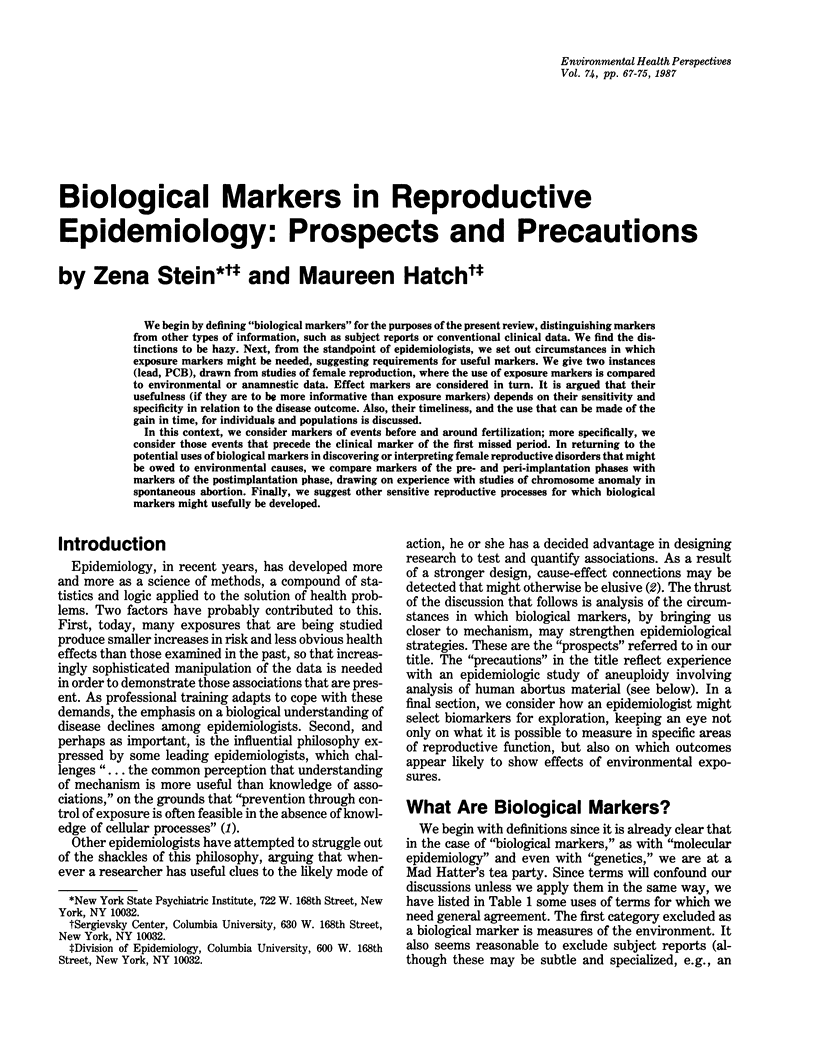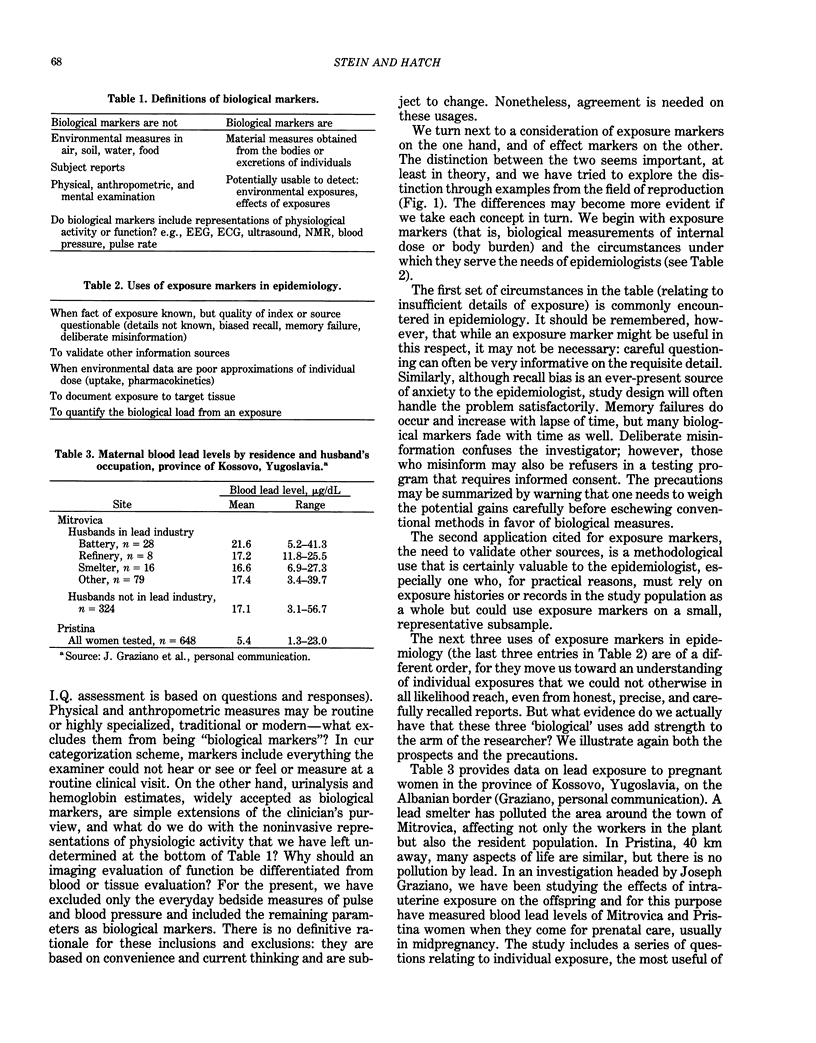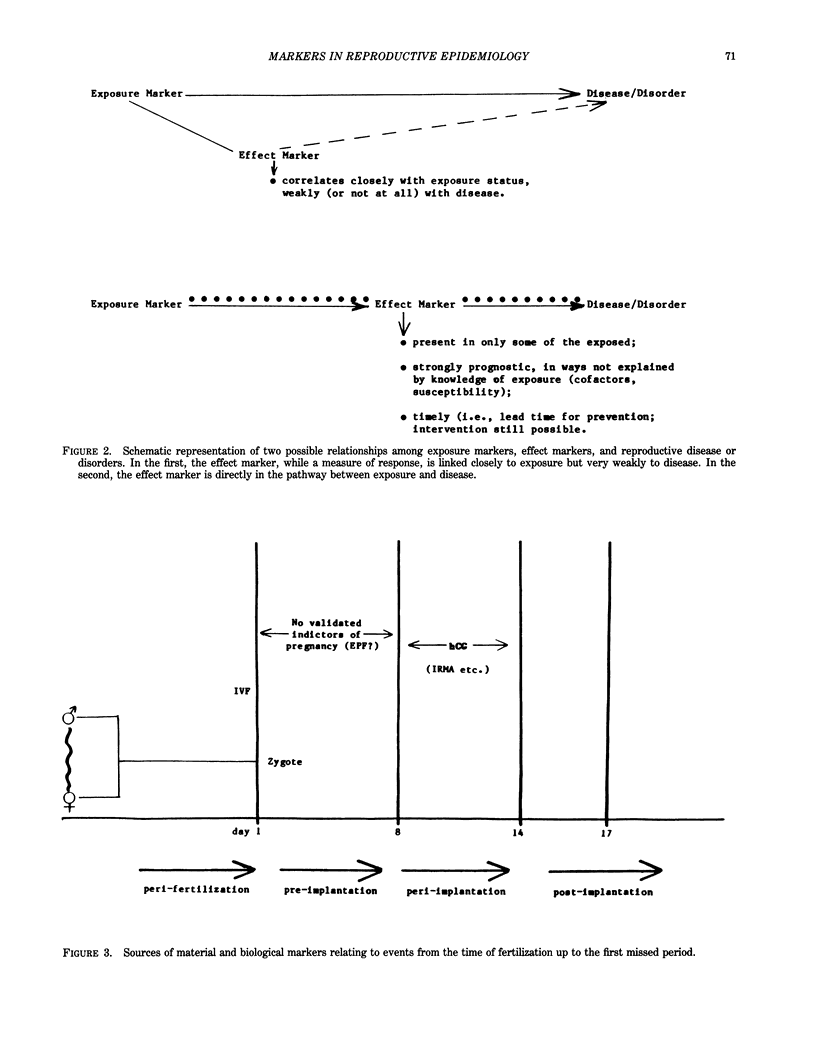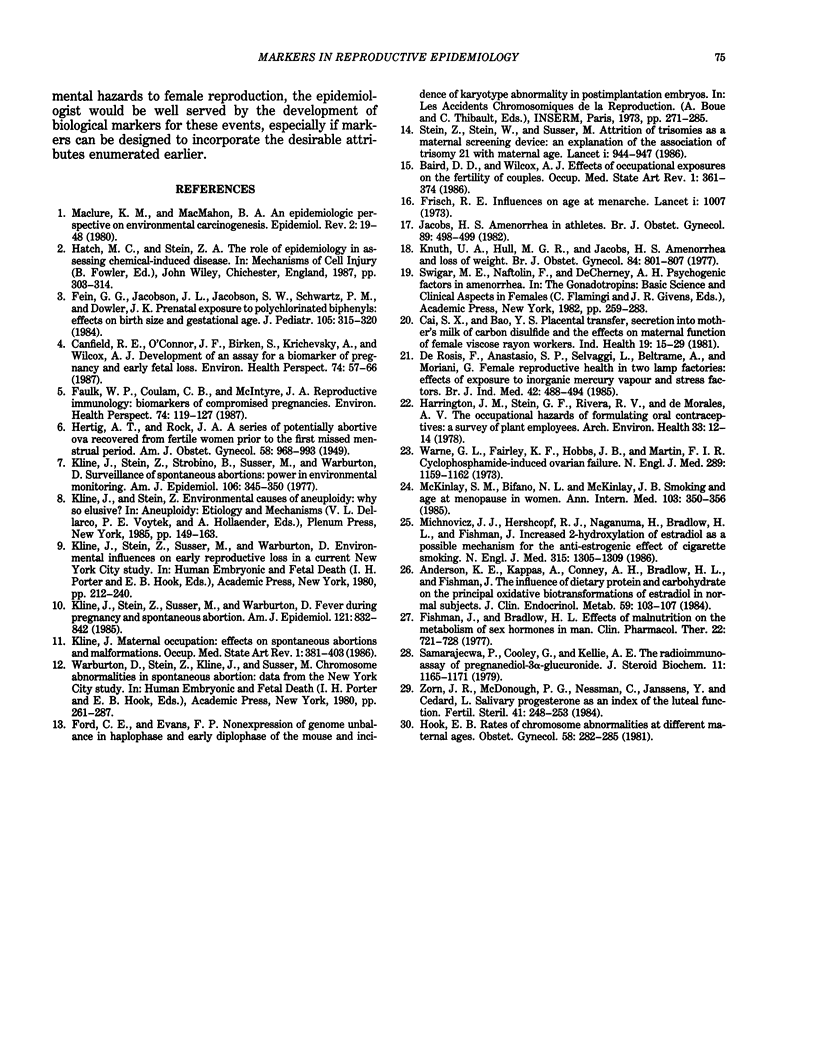Abstract
We begin by defining "biological markers" for the purposes of the present review, distinguishing markers from other types of information, such as subject reports or conventional clinical data. We find the distinctions to be hazy. Next, from the standpoint of epidemiologists, we set out circumstances in which exposure markers might be needed, suggesting requirements for useful markers. We give two instances (lead, PCB), drawn from studies of female reproduction, where the use of exposure markers is compared to environmental or anamnestic data. Effect markers are considered in turn. It is argued that their usefulness (if they are to be more informative than exposure markers) depends on their sensitivity and specificity in relation to the disease outcome. Also, their timeliness, and the use that can be made of the gain in time, for individuals and populations is discussed. In this context, we consider markers of events before and around fertilization; more specifically, we consider those events that precede the clinical marker of the first missed period. In returning to the potential uses of biological markers in discovering or interpreting female reproductive disorders that might be owed to environmental causes, we compare markers of the pre- and peri-implantation phases with markers of the postimplantation phase, drawing on experience with studies of chromosome anomaly in spontaneous abortion. Finally, we suggest other sensitive reproductive processes for which biological markers might usefully be developed.
Full text
PDF








Selected References
These references are in PubMed. This may not be the complete list of references from this article.
- Anderson K. E., Kappas A., Conney A. H., Bradlow H. L., Fishman J. The influence of dietary protein and carbohydrate on the principal oxidative biotransformations of estradiol in normal subjects. J Clin Endocrinol Metab. 1984 Jul;59(1):103–107. doi: 10.1210/jcem-59-1-103. [DOI] [PubMed] [Google Scholar]
- Baird D. D., Wilcox A. J. Effects of occupational exposures on the fertility of couples. Occup Med. 1986 Jul-Sep;1(3):361–374. [PubMed] [Google Scholar]
- Cai S. X., Bao Y. S. Placental transfer, secretion into mother milk of carbon disulphide and the effects on maternal function of female viscose rayon workers. Ind Health. 1981;19(1):15–29. doi: 10.2486/indhealth.19.15. [DOI] [PubMed] [Google Scholar]
- Canfield R. E., O'Connor J. F., Birken S., Krichevsky A., Wilcox A. J. Development of an assay for a biomarker of pregnancy and early fetal loss. Environ Health Perspect. 1987 Oct;74:57–66. doi: 10.1289/ehp.877457. [DOI] [PMC free article] [PubMed] [Google Scholar]
- De Rosis F., Anastasio S. P., Selvaggi L., Beltrame A., Moriani G. Female reproductive health in two lamp factories: effects of exposure to inorganic mercury vapour and stress factors. Br J Ind Med. 1985 Jul;42(7):488–494. doi: 10.1136/oem.42.7.488. [DOI] [PMC free article] [PubMed] [Google Scholar]
- Faulk W. P., Coulam C. B., McIntyre J. A. Reproductive immunology: biomarkers of compromised pregnancies. Environ Health Perspect. 1987 Oct;74:119–127. doi: 10.1289/ehp.8774119. [DOI] [PMC free article] [PubMed] [Google Scholar]
- Fein G. G., Jacobson J. L., Jacobson S. W., Schwartz P. M., Dowler J. K. Prenatal exposure to polychlorinated biphenyls: effects on birth size and gestational age. J Pediatr. 1984 Aug;105(2):315–320. doi: 10.1016/s0022-3476(84)80139-0. [DOI] [PubMed] [Google Scholar]
- Fishman J., Bradlow H. L. Effect of malnutrition on the metabolism of sex hormones in man. Clin Pharmacol Ther. 1977 Nov;22(5 Pt 2):721–728. doi: 10.1002/cpt1977225part2721. [DOI] [PubMed] [Google Scholar]
- Frisch R. E. Influences on age of menarche. Lancet. 1973 May 5;1(7810):1007–1007. doi: 10.1016/s0140-6736(73)91657-7. [DOI] [PubMed] [Google Scholar]
- HERTIG A. T., ROCK J. A series of potentially abortive ova recovered from fertile women prior to the first missed menstrual period. Am J Obstet Gynecol. 1949 Nov;58(5):968-93, illust. doi: 10.1016/0002-9378(49)90203-3. [DOI] [PubMed] [Google Scholar]
- Harrington J. M., Stein G. F., Rivera R. O., de Morales A. V. The occupational hazards of formulating oral contraceptives--a survey of plant employees. Arch Environ Health. 1978 Jan-Feb;33(1):12–15. doi: 10.1080/00039896.1978.10667301. [DOI] [PubMed] [Google Scholar]
- Hook E. B. Rates of chromosome abnormalities at different maternal ages. Obstet Gynecol. 1981 Sep;58(3):282–285. [PubMed] [Google Scholar]
- Jacobs H. S. Amenorrhea in athletes. Br J Obstet Gynaecol. 1982 Jul;89(7):498–500. doi: 10.1111/j.1471-0528.1982.tb03647.x. [DOI] [PubMed] [Google Scholar]
- Kline J. K. Maternal occupation: effects on spontaneous abortions and malformations. Occup Med. 1986 Jul-Sep;1(3):381–403. [PubMed] [Google Scholar]
- Kline J., Stein Z., Strobino B., Susser M., Warburton D. Surveillance of spontaneous abortions. Power in environmental monitoring. Am J Epidemiol. 1977 Nov;106(5):345–350. doi: 10.1093/oxfordjournals.aje.a112475. [DOI] [PubMed] [Google Scholar]
- Kline J., Stein Z., Susser M., Warburton D. Fever during pregnancy and spontaneous abortion. Am J Epidemiol. 1985 Jun;121(6):832–842. doi: 10.1093/oxfordjournals.aje.a114054. [DOI] [PubMed] [Google Scholar]
- Knuth U. A., Hull M. G., Jacobs H. S. Amenorrhoea and loss of weight. Br J Obstet Gynaecol. 1977 Nov;84(11):801–807. doi: 10.1111/j.1471-0528.1977.tb12499.x. [DOI] [PubMed] [Google Scholar]
- Maclure K. M., MacMahon B. An epidemiologic perspective of environmental carcinogenesis. Epidemiol Rev. 1980;2:19–48. doi: 10.1093/oxfordjournals.epirev.a036222. [DOI] [PubMed] [Google Scholar]
- McKinlay S. M., Bifano N. L., McKinlay J. B. Smoking and age at menopause in women. Ann Intern Med. 1985 Sep;103(3):350–356. doi: 10.7326/0003-4819-103-3-350. [DOI] [PubMed] [Google Scholar]
- Michnovicz J. J., Hershcopf R. J., Naganuma H., Bradlow H. L., Fishman J. Increased 2-hydroxylation of estradiol as a possible mechanism for the anti-estrogenic effect of cigarette smoking. N Engl J Med. 1986 Nov 20;315(21):1305–1309. doi: 10.1056/NEJM198611203152101. [DOI] [PubMed] [Google Scholar]
- Peters J. P., Man E. B. THE INTERRELATIONS OF SERUM LIPIDS IN PATIENTS WITH DISEASES OF THE KIDNEYS. J Clin Invest. 1943 Sep;22(5):721–726. doi: 10.1172/JCI101445. [DOI] [PMC free article] [PubMed] [Google Scholar]
- Samarajeewa P., Cooley G., Kellie A. E. The radioimmunoassay of pregnanediol-3 alpha-glucuronide. J Steroid Biochem. 1979 Aug;11(2):1165–1171. doi: 10.1016/0022-4731(79)90169-9. [DOI] [PubMed] [Google Scholar]
- Warne G. L., Fairley K. F., Hobbs J. B., Martin F. I. Cyclophosphamide-induced ovarian failure. N Engl J Med. 1973 Nov 29;289(22):1159–1162. doi: 10.1056/NEJM197311292892202. [DOI] [PubMed] [Google Scholar]
- Zorn J. R., McDonough P. G., Nessman C., Janssens Y., Cedard L. Salivary progesterone as an index of the luteal function. Fertil Steril. 1984 Feb;41(2):248–253. doi: 10.1016/s0015-0282(16)47599-0. [DOI] [PubMed] [Google Scholar]


